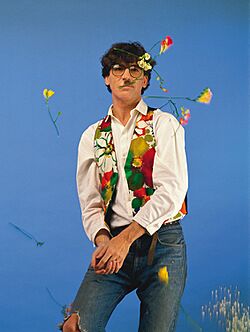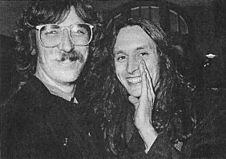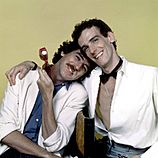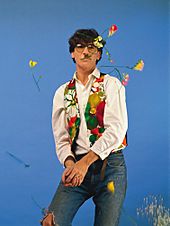Charly García facts for kids
Carlos Alberto García Moreno (born October 23, 1951), known by his stage name Charly García, is a famous Argentine musician. He is a singer, songwriter, and producer. Many people call him "the father of Argentine rock." He is one of the most important rock musicians in Argentina and Latin America.
García is known for his work in many bands and as a solo artist. He has explored many music styles, including folk rock, pop, jazz, and new wave. His lyrics often talked about life in Argentina. He was especially critical of the government during a difficult time in Argentina's history called the National Reorganization Process. This was a period when a military government ruled the country.
In the 1970s, he started the band Sui Generis with his friend Nito Mestre. The band became very popular with young people. After Sui Generis, he formed other important bands like La Máquina de Hacer Pájaros and Serú Girán. Serú Girán is considered one of the greatest bands in Argentine music history.
In 1982, García began a successful solo career. He released famous albums like Clics modernos and Piano Bar. These albums are seen as some of the best in Argentine rock. Throughout his career, he has won many awards, including a Grammy Award for Musical Excellence.
Biography
A Musical Childhood
Carlos Alberto García was born in Buenos Aires, Argentina, on October 23, 1951. His family was well-off. His father owned a factory, and his mother produced radio and TV shows about music.
Music was part of Charly's life from a very young age. He had a toy piano and learned to play songs by ear. When his parents saw his talent, they hired a piano teacher for him. His teacher, Julieta Sandoval, was very strict. She wanted him to become a great classical pianist.
Charly's first public performance was in 1956, when he was only four years old. He loved classical music by composers like Chopin and Mozart. At age nine, he composed his first piece of music.
Discovering Rock and Roll
In 1964, everything changed when Charly heard The Beatles for the first time. He was amazed by their music. He realized that young people could write and perform their own songs. This inspired him to move away from classical music.
He asked for an electric guitar, grew his hair long, and started a band with his school friends. The band was called To Walk Spanish. They wrote their own songs in English and played covers of bands like The Byrds. This was the beginning of his journey into rock music.
Career with Music Groups
Sui Generis (1972–1975)
In high school, Charly met Nito Mestre. Together, they formed the band Sui Generis. At first, the band had six members. They played a mix of rock, blues, and other styles.
After some members left, Sui Generis became a duo with just Charly and Nito. They played acoustic folk-rock music. Their songs connected with young people in Argentina. In 1973, they released their first album, Vida. It was a huge success. The song "Canción para mi muerte" ("Song for My Death") became an anthem for a generation.
Their second album, Confesiones de invierno ("Winter Confessions"), was also very popular. It included the famous song "Rasguña las piedras" ("Scratch the Stones"), a powerful call for freedom.
For their third album, Pequeñas anécdotas sobre las instituciones ("Little Anecdotes about the Institutions"), the band's sound changed. They used more electronic instruments and played symphonic rock. The lyrics were critical of the government and society. Because of this, some songs had to be changed or removed from the album to avoid problems with the authorities.
By 1975, Charly wanted to explore new musical ideas. The band decided to break up. They held a massive farewell concert called Adiós Sui Géneris at the Luna Park stadium. Thousands of fans came to say goodbye. The concert was filmed and turned into a movie and a live album.
La Máquina de Hacer Pájaros (1976–1977)
After Sui Generis, Charly started a new band called La Máquina de Hacer Pájaros ("The Bird-Making Machine"). This band played complex symphonic rock. It was one of the first Argentine bands to have two keyboard players at the same time.
The band released two albums, La Máquina de Hacer Pájaros and Películas ("Movies"). The music was very advanced for its time. However, it was not as popular with the public as Sui Generis had been. The band broke up in 1977.
Serú Girán (1978–1982)
In 1978, Charly formed the supergroup Serú Girán. The band included David Lebón (guitar), Pedro Aznar (bass), and Oscar Moro (drums). They are often called "The Argentine Beatles" because of their talent and popularity.
Their first concert was not well-received. The audience wanted to hear old Sui Generis songs. But the band kept playing their new music, and soon people began to love their unique style.
Serú Girán released four studio albums. Their lyrics often contained hidden messages that criticized the military government in Argentina. For example, the song "Canción de Alicia en el país" ("Song of Alice in the Country") used the story of Alice in Wonderland to talk about the political situation.
The band became one of the most successful in Argentine history. They broke up in 1982 when Pedro Aznar left to study music in the United States. They had a final concert that was released as the live album No llores por mí, Argentina ("Don't Cry for Me, Argentina").
Solo Career
Early Success (1982–1985)
In 1982, Charly García began his solo career. He released a double album that included the soundtrack for the movie ... Angelical and the album Yendo de la cama al living ("Going from the Bed to the Living Room").
The album had powerful songs about the political situation in Argentina. "No bombardeen Buenos Aires" ("Don't Bomb Buenos Aires") was about the fear people felt during the Falklands War. The album's presentation at a stadium in Buenos Aires was a huge event.
In 1983, he released Clics Modernos ("Modern Clicks"). This album had a new, danceable sound. It included the song "Los dinosaurios" ("The Dinosaurs"), which was a tribute to the people who had disappeared during the military dictatorship.
His next album, Piano Bar (1984), continued his success. These three albums are considered a "golden trilogy" in his career.
Stardom and Classic Albums (1985–1989)
In 1987, García released Parte de la Religión ("Part of the Religion"). It became another classic album with hit songs like "No voy en tren" ("I Don't Take the Train").
In 1988, he performed at the Amnesty International festival in Buenos Aires. He shared the stage with international stars like Peter Gabriel and Bruce Springsteen.
In 1989, he released the album Cómo conseguir chicas ("How to Get Girls"). His music started to become darker and more experimental.
The 'Say No More' Era (1994–2000)
After a few years, García returned in 1994 with the album La hija de "La Lágrima" ("The Tear's Daughter"). This album introduced a new concept he called Say No More.
In 1995, he recorded an Hello! MTV Unplugged album, which was very successful. The album Say No More was released in 1996. García said it was a new way of making music, like a painter working directly on a canvas.
In 1999, he played a huge free concert in Buenos Aires for 250,000 fans. It was one of the biggest concerts in Argentina's history.
Later Years and Comeback
In 2000, Charly and Nito Mestre reunited as Sui Generis. They released a new album, Sinfonías para adolescentes ("Symphonies for Adolescents"), and played a massive concert at the Boca Juniors stadium.
García continued his solo career with albums like Influencia (2002) and Rock and Roll, Yo (2003). After 2004, he took a break from the public eye to focus on his health.
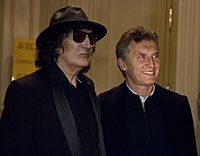
He made a big comeback in 2009 with a new song and a tour. On his 58th birthday, he played a concert in a stadium during a heavy rainstorm, which became known as "The Underwater Concert."
In 2017, he released the album Random, his first studio album in seven years. In 2021, the Argentine government celebrated his 70th birthday with a special event where many musicians performed his songs. Charly himself made a surprise appearance and played for the crowd.
In 2024, García released his latest solo album, La lógica del escorpión ("The Scorpion's Logic"). It featured famous guest musicians and became very popular, with many of its songs reaching the top of the music charts in Argentina.
Discography
- 1972: Vida
- 1973: Confesiones de Invierno
- 1974: Pequeñas anécdotas sobre las instituciones
- 1975: Alto en la Torre (EP)
- 1975: Adiós Sui Géneris I & II
- 1996: Adiós Sui Géneris III
- 2000: Sinfonías para adolescentes
- 2001: Si - Detrás de las Paredes
- PorSuiGieco
- 1976: Porsuigieco
- La Máquina de Hacer Pájaros
- 1976: La Máquina de Hacer Pájaros
- 1977: Películas
- With Serú Girán
- 1978: Serú Girán
- 1979: La Grasa de las Capitales
- 1980: Bicicleta
- 1981: Peperina
- 1982: No llores por mí, Argentina
- 1992: Serú '92
- Solo
- 1982: ... Angelical/Yendo de la Cama al Living
- 1983: Clics modernos
- 1984: Piano Bar
- 1987: Parte de la Religión
- 1989: Cómo Conseguir Chicas
- 1990: Filosofía Barata y Zapatos de Goma
- 1994: La Hija de la Lágrima
- 1995: Hello! MTV Unplugged
- 1996: Say No More
- 1998: El Aguante
- 2002: Influencia
- 2003: Rock and Roll Yo
- 2010: Kill Gil
- 2017: Random
- 2024: La lógica del escorpión
- With Pedro Aznar
- 1986: Tango
- 1991: Tango 4
- With Mercedes Sosa
- 1997: Alta fidelidad
Images for kids
See also
 In Spanish: Charly García para niños
In Spanish: Charly García para niños


